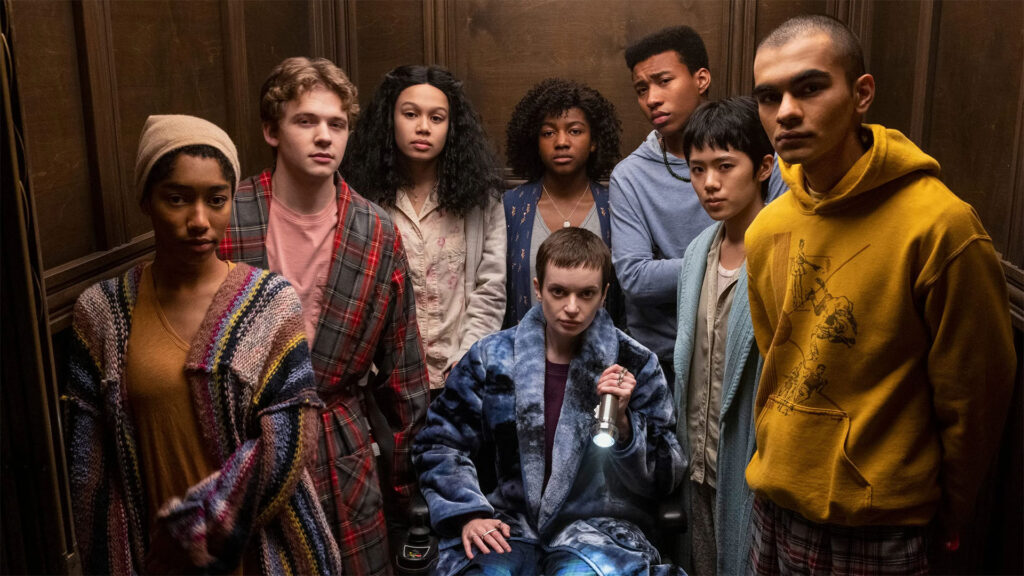Since The Hunting of Hill House, Mike Flanagan has been on a mission to provide dramatic horror series on Netflix. This time it’s called The Midnight Club and it’s based on Christopher Pike’s book of the same name. It takes place in the 1990s at Brightcliffe, a hospice where teens with terminal illnesses can live out their final days with dignity and in the company of people who understand what they’re going through. The club is all about: the kids sneak out to the library at midnight, sit at a large table wrapped in their housecoats, and “make ghosts” by telling each other stories.
When our main protagonist Ilonka (Iman Benson) learns she was accepted to Stanford, she immediately starts making big plans for the future. However, as she finds out about her diagnosis, everything completely evaporates. After some research, she convinces her foster father that she wants to move to Brightcliffe instead. Her decision to live with a group of strangers rather than her family at first seems strange. But as we learn more about Brightcliffe and its past, Ilonka’s decision makes more sense.
The show is basically split into two parts. On one hand, there are some adults and their side plots. Each episode contains a new story- ranging from classic detective adventures to a thriller about creepy doppelgängers- that is both an excellent standalone and also provides important insights into the storyteller’s life and history. The Midnight Club’s highlights are these stories. Between all this, the group gets to know each other well throughout the ten episodes.
Whereas Midnight Mass struggled with characters constantly jumping into lengthy monologues about their lives, The Midnight Club doesn’t have that problem; the latter feels much more natural and interesting: the monologues are the story. They’re fireside ghost stories with just enough reality to knock you out when you figure out what they’re about.
The cast contributed a lot to this show. We bet you wouldn’t guess that most of the children at Brightcliffe were played by relatively inexperienced actors, because they are all so talented. Each member of the group contributes something unique and valuable to the group: Natsuki (Aya Furukawa) struggles to connect because of a deep-seated depression. Anya (Ruth Codd) is a big softie who pretends to be tough and mean. Amish (Sauriyan Sapkota) hides his heartbreak behind humor. Cheri (Adia) is a compulsive liar who uses outrageous stories to tell real truths. Nevertheless, it is frequently heartbreaking and yet beautiful to witness these teens cope with such extraordinary challenges.
This show depicts what it’s like to be diagnosed with a fatal condition at such a young age; how quickly life can change. One minute you’re laughing with your family. The next, you’re talking to your doctor about how long you’ll live.
Although The Midnight Club members were initially strangers, through them we see how strangers can become families, and families can become strangers. The series also demonstrates that it is impossible to let go of someone you care about; you will do anything in your power to save them, even if you know you can’t change reality.
However, the show’s other side falls short of the ghost stories. Brightcliffe, like Hill House and Bly Manor, has a troubled past. There are ghost stories and true exposition of a murderous cult. The story of a young girl performing a ritual that eventually cured her was part of what drew Ilonka to the hospice in the first place. Some believe the grounds have a healing aura that can be channeled in the right way. These mysteries first manifest themselves in intriguing ways: flashbacks to bloody rituals; the appearance of very eerie ghosts. Because the kids are on so many medications, they never know if they’re hallucinating or not. But these threads never really went anywhere.
The overarching supernatural element of mystery feels underdeveloped compared to the rest of the show. The show even concludes with a cliffhanger-style twist.
It’s a shame that The Midnight Club’s two sides never come together completely, but the ghost stories and the core group of young stars are more than enough to carry the show. It’s like a series of creepy short stories, but each one becomes more meaningful as the show progresses. At the very least, Flanagan’s horror series is consistent, and it’s becoming an annual event. The Midnight Club was considered for a second season, but Netflix ultimately decided not to renew it. Nevertheless, this is highly unlikely to be the last of Mike Flanagan’s horror output for Netflix. Let’s see what he cooks up next.
